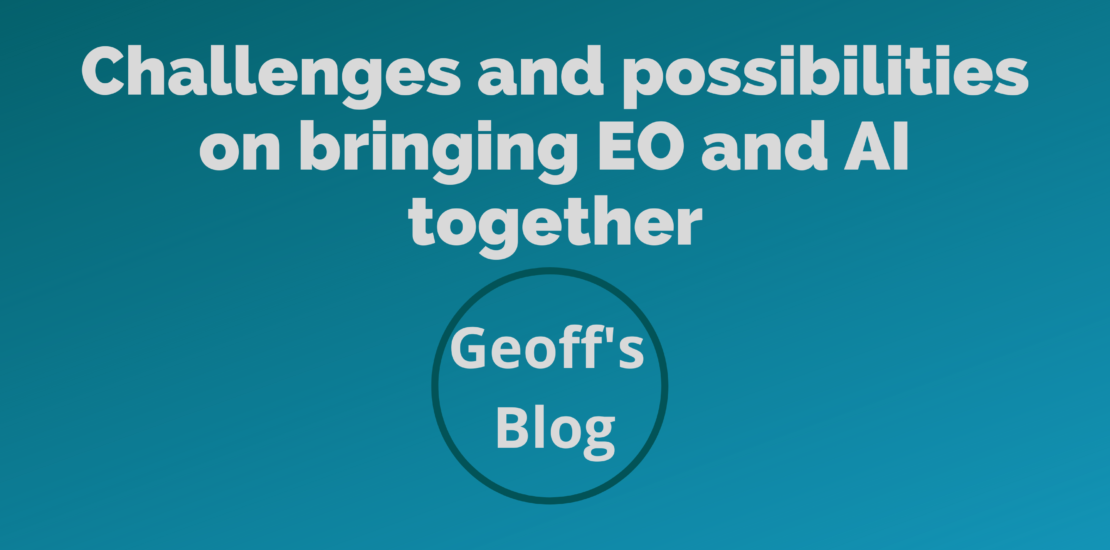- February 11, 2021
- Posted by: EARSC
- Categories: Blogs, Geoff's Blog

By Sandra Cabrera Alvarado, Aaron Scorsa, Geoff Sawyer
Approximately 180 attendees gathered on the EARSC second EOcafe of 2021 to learn more on how Artificial Intelligence (AI) can help improve and interact with Earth Observation (EO) services. Both of our invited guests represent the community of AI developers and the community of EO service companies to give a wider perspective on the topic.
Nicolas Longepe – EO data Scientist in the European Space Agency’s Φ-lab (Phi-lab)- explained how the ESA Φ-lab provides the platform for companies and individuals to become more familiar with EO services and especially to bring new technology to bear upon the sector. The recent focus has been on AI and new missions even sometimes combined. This has led to establishing the AI4EO project initiative. Nicolas also cited the In-cubed programme as of possible interest for those seeking to develop new activities/products together with ESA’s help.
Annekatrien Debien -Head of the Brussels office of SpaceTec Partners and lead of the AI4EO project– considers that bridging the two communities is not an easy task. In fact, the AI community is very diverse since AI is a transversal tool. Why? Due to the mix of industrial and research experts in the AI community. It is clear that satellite images are not just a picture from which you extract only one parameter, but a complex dataset that aims to tackle complex challenges that can actually profit from AI community knowledge.
All of the datasets taken from the satellites could get some insights on the parameters using AI. Thanks to AI, in general we are talking about prediction, detection, classification, big data analytics and super resolution emulation. Therefore, there is knowledge in both communities that can be complementary. However, one of the main challenges is to bridge the gap between the AI and the EO by fostering its use for example in the scientific community.
Dealing with EO problems, AI can be considered as a transversal and beneficial tool for EO contributing with all its techniques. For example, CNN (Computer Neural Network) which is adopted for segmentation (SAR) or GAN (Generating Adversal Network) for synthesizing images, mostly based on computer vision technics. Nevertheless, although a lot of different functions are already used there is still the need to explore them as only a small part of AI techniques are used. Linking the communities, finding partners and expertise remains the main challenge. To address this, Annakatrien currently the first phase is to build awareness in both communities to introduce both technologies. In addition, she explained the AI4EO challenge on air quality monitoring using Sentinel data promoted by ECMWF[1] is currently open and encourages the industry to submit its applications.[2]
Another issue perceived by the audience is the existing limitations on the robustness of the techniques and how both communities can benefit from their experiences to overcome such limitations. In addition, big data management should also need to be taken into consideration and the cloud solution, linked to the need to sustainability. This is illustrated by the use of Google and Amazon platforms and the place that the DIAS can play to address this demand. The audience also pointed out a limitation which is the lack of governmental research and data to reach a better understanding on how to get open tools, such as machine learning to explore the access to data, while academic and industry work are available.
Prompted by many questions from those in the EOcafe, Nicolas recognized that there should be more training efforts to provide access to data and other capacity building activities to raise awareness on AI and other technologies which is also a subject of interest for the Φ-lab. On the same line, the attendees also expressed their wish to know more on AI data trainings and object identification in AI and EO resolution gap. Trust on algorithms was a possible answer by Nicolas to start to resolve this applicability between these technologies.
Despite these concerns and issues raised, it was pointed out that there are already applications using AI in the EO community using models or algorithms with several levels of maturity that could be taken into consideration for the future of EO and AI possible synergy.
Finally, several attendees took the opportunity to promote resources and future events:
- Workshop under the EO4GEO project on 2nd March[3] (Daniela Iasillo).
- AI toolbox available called AiTLAS[4] (Dragi Kocev – Bias Variance Labs)
- A session on AI planned at IGARSS 2021 (Vasilis Kalogirou – EU SatCen).
- Machine Learning Datasets Library[5]
To assist AI and EO communities on fostering partnerships please write to AI4EO via the website[6]. Any EARSC member wishing to get involved can also contact the secretariat who will be pleased to help where possible.
[1] European Centre for Medium-Range Weather Forecasts, [2] For applications submission visit: www.ai4eu.eu, [3] See www.eo4geo.eu ,
[4] See https://github.com/biasvariancelabs/aitlas/, [5] See https://www.paperswithcode.com/datasets, [6] For applications submission visit: www.ai4eu.eu
